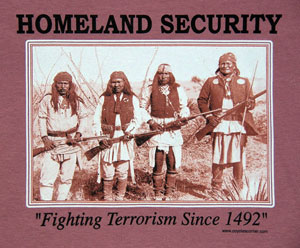Relocation
As we learned in Freedom Fighters in Geronimo, Cochise and the Chiricahua Apaches had agreed to live in peace on their ancestral homeland. The narrative continues:
With minimal interference from the US, the Apaches lived much as they always had, raiding into Mexico for horses and supplies. Two years later, Cochise died, and the agreement with the Americans was put at risk.
Cochise's death was an irreplaceable loss to the Chiricahuas but an opportunity to the US. With him gone, the Americans decided to move the Chiricahuas 150 miles north to a mosquito-ridden reservation called San Carlos. This would open the valuable Chiricahua land to American mining and settlement, and appease the Mexicans, who were fed up with Apache raiding.
The Chiricahuas reluctantly agreed to move. Geronimo said he'd go with them, but that night, he fled with Chief Juh and 700 Chiricahuas. It was the first of several times he would flee.
Unfortunately, he soon rode into a carefully-laid trap. Apache scouts surrounded him and the US forces carted him back to San Carlos in chains.
He thought they would execute him, but eventually they released him. But they forced him to wear an identity tag, attend a daily headcount, and obtain a pass to go anywhere. They ordered him to dig ditches and plant vegetables like a farmer, even though the land was poor. For four years he endured this unsatisfying life.
The Dreamer
In 1881, the Apaches were drawn to the startling message of a charismatic medicine man, called the Dreamer. A former military scout well-versed in American ways, he urged a return to traditional Apache life. Apaches came from miles around to attend his ceremonies.
The scouts who had "mutinied" were hanged. The New York Times called it a massacre as bad as Custer's Last Stand. The anxious Army called for reinforcements and soon San Carlos was swarming with soldiers. No one felt more endangered than Geronimo.
Thinking the Army would kill him next, Geronimo escaped and headed south with Juh and 72 Chiricahuas. In the Apache stronghold, Geronimo joined the greatest Apache force assembled since Cochise. It was the beginning of five years of bloody Chiricahua resistance--the last Indian war. They were the only Indians still fighting the US Army.
No more Mr. Nice Guy
We don't know the motivations of the other Apaches. But at this point, we can speculate about Geronimo's. He had lived in peace at San Carlos for four years, which implies some acceptance of the status quo. Unlike Tecumseh, he hadn't been a leader with a vision of tribal unity and independence. It seems his motives were mainly selfish: to stay alive and free.
Fearing for his life would be a valid reason to keep fighting the Army, but it wouldn't justify murder or mutilation. The episode doesn't say how "bloody" the rebellion was, but I presume some civilians died. Geronimo was losing the moral high ground his people had once occupied. Before the struggle had been to preserve Apache sovereignty; now it was to preserve himself.
Geronimo cemented this sense of entitlement when he came up with an audacious plan. Worried that he couldn't last long with his small force, he returned to San Carlos and abducted 400 Chiricahuas led by Chief Loco. They would join the resistance or he would shoot them.
Geronimo led Loco and his band on a harrowing trip to the stronghold. On the way, they fell into a Mexican ambush and 78 Apaches were killed. The survivors blamed Geronimo. "We were filled with gloom and despair," said one. "What had we done to be treated so cruelly by our own race?"
Life in the stronghold was hard. One Apache called Tzoe or Peaches returned to San Carlos on his own. Soldiers strung him up until he told them where Geronimo was.
When the Army breached the Apache stronghold, it was a shattering psychological blow. Geronimo had a premonition that the game was up. Reluctantly he and his followers agreed to return to San Carlos.
Summing it up
There's no excuse for kidnapping your own people and forcing them to join your crusade. Loco's followers wanted to settle down and that was their right. Geronimo didn't have the right to superimpose his wishes on theirs.
Not only was his plan immoral and inhumane, it was just plain dumb. If Geronimo couldn't convince the Apaches to join him voluntarily, he didn't have much of a chance. Loco's people wouldn't have fought bravely under duress. Rather, they would've hindered or ruined the runaways' efforts. When your goal is to move silently and swiftly, you don't want hundreds of malcontents getting in the way. They're only going to stall, complain, and threaten to leave.
So Geronimo's excuses for killing people were pretty much done. He'd have a hard time arguing he was fighting a war when his people were settling down, joining the Army as scouts, and hunting him like a common criminal. No, his glory days were definitely over.
For more on the subject, see Freedom Fighters in Geronimo and Review of Geronimo.


No comments:
Post a Comment